Past Events
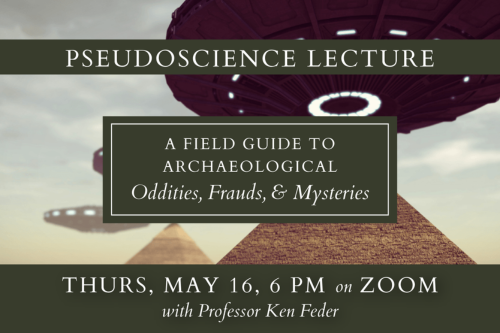 A Field Guide to Archaeological Oddities, Frauds, and Mysteries
A Field Guide to Archaeological Oddities, Frauds, and Mysteries
Is there archaeological evidence that giant human-like creatures once walked the Earth? Did a contingent of the Lost Tribes of Israel visit New Mexico, marking their presence by etching the Ten Commandments in Hebrew into a boulder southwest of Albuquerque? Did ancient Druids establish a colony in southern New Hampshire where they carved a table designed to collect the blood of sacrificial victims? Was an earth mound in Ohio inspired by a precociously sophisticated lost civilization that was utterly destroyed 12,500 years ago? Did Native Americans encounter visitors from other planets, recording that experience by painting images of space-suited aliens on canyon walls in Utah? Finally, have archaeologists discovered the far western outpost of an ancient Egyptian pharaoh, not in Egypt or even Africa, but in, of all places, California? Dr. Ken Feder will here reveal the hidden truth underlying these ancient mysteries. Spoiler alert: The answer to each of them is a resolute “no!” Nevertheless, the stories behind these and other false claims about the ancient past are fascinating and, it must be admitted, occasionally even a little hilarious. Oh, and bonus – Dr. Feder will tell you how you can personally visit these places and see them for yourselves.
Ken Feder, PhD, is professor emeritus (Anthropology) at Central Connecticut State University in New Britain, Connecticut. His primary research interests include the archaeology of the native peoples of New England and the analysis of public perceptions about the human past. He is the author of several books including Frauds, Myths, and Mysteries: Science and Pseudoscience in Archaeology (Oxford University Press, 2020, 10th edition); The Past in Perspective: An Introduction to Human Prehistory (Oxford University Press, 2020, 8th edition); Ancient America: Fifty Archaeological Sites to See for Yourself (Rowman & Littlefield, 2017); and Archaeological Oddities: A Field Guide to Forty Claims of Lost Civilizations, Ancient Visitors, and Other Strange Sites in North America (Rowman & Littlefield, 2019). He has served as a talking head on numerous television documentaries about humans. On the topic of human antiquity, one producer described him as being “a beacon of sanity in a sea of madness,” which actually is a very scary thought.
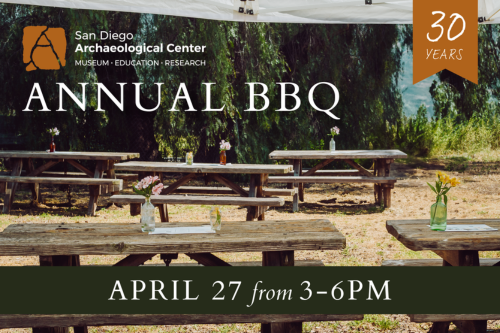 Annual BBQ
Annual BBQ
Join us for an afternoon of food, lively entertainment, and a gathering of San Diego’s archaeological community. Proceeds support our work preserving San Diego County’s archaeological record as well as school programs, lectures, workshops, and exhibits throughout the year.
This year, we’re serving up tacos from Frida’s Taqueria. Enjoy carne asada, pollo asada, carnitas, jackfruit adovada, colorful agua frescas, and craft beer at our open bar.
Test your aim at our popular archery and atlatl range, connect with professional archaeologists from local CRM firms, and discover great finds at the silent auction. Local archaeologist and musician Dr. Timothy Gross will perform with his band. Guests will have chances to win SDAC merchandise, a cabin getaway, and more with opportunity drawings and Member Prize Wheel.
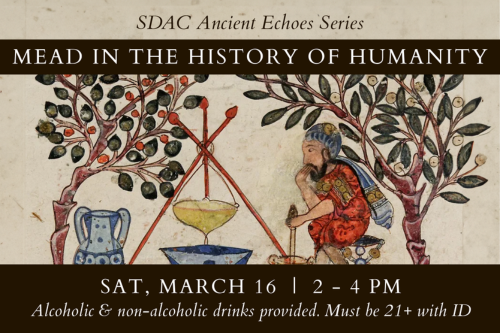 Ancient Echoes: Mead in the History of Humanity
Ancient Echoes: Mead in the History of Humanity
It’s been known by many names: “Nectar of the Gods,” “Ambrosia,” “Balché,” and “Mead.” Regardless of what it was called, this golden liquid is believed to be the oldest alcoholic beverage ever brewed. In this second installment of our Ancient Echoes series, you’ll not only learn about this mysterious drink’s place in history but also how mead is made today with a behind-the-scenes tour of Twisted Horn Mead & Cider. Tickets include mead tasting. This event is 21+.
Twisted Horn Mead & Cider is located in Vista, California. Mead and cider’s histories date back thousands of years to when something that wasn’t quite beer and wasn’t quite wine emerged on the market. Unique and fantastical drinks indeed they were that offered flavors that beer and traditional wines could not. As time passed, fruits, spices and other adjunct flavors were also added to further enhance the already unique flavor profiles. Capitalizing on creativity and only using the best quality of those very ingredients, is what gave rise to this truly unique and extraordinary location. At Twisted Horn, mead and cider offerings are “Old World Style With a Twist”.
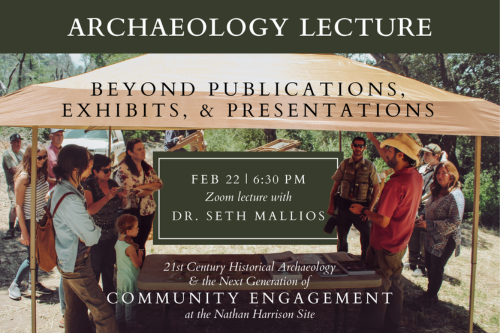 Beyond Publications, Exhibits, and Presentations: 21st Century Historical Archaeology and the Next Generation of Community Engagement at the Nathan Harrison Site
Beyond Publications, Exhibits, and Presentations: 21st Century Historical Archaeology and the Next Generation of Community Engagement at the Nathan Harrison Site
The Nathan Harrison Historical Archaeology Project has been a twenty-year undertaking that seeks to understand and communicate the life and legacies of San Diego County’s first African American homesteader. It employs orthogonal thought and archaeological, anthropological, and historical tools of analysis to bring marginalized voices to diverse publics. The remote mountain-top site was home during the late nineteenth and early twentieth centuries to Nathan Harrison. He was born into slavery, endured horrors of the Antebellum South, the mania of the Gold Rush, and racial injustices of the Old West. Harrison gained mythical status during his life and after his passing. While alive, he was embraced by multiple communities, and his story has since been used by different groups over time for a variety of causes. This talk examines how our archaeology has inspired a new generation of muralists, historians, playwrights, and others to create innovative works and continued relevance for Nathan Harrison’s evolving narratives. It offers a brief Harrison biography, an overview of the project, an explanation of Harrison’s dual identity, code-switching, and historical minstrelsy, and a discussion of the project’s case for significance beyond the dig, including public exhibits, educational curricula, and creative arts.
Seth Mallios is Professor of Anthropology, University History Curator, and Director of the South Coastal Information Center at San Diego State University. He received his BA from the University of California, Berkeley, and his PhD from the University of Virginia. An archaeologist, anthropologist, and historian, Dr. Mallios engages in scientific and humanistic community-based research that offers insights into past and present issues of identity, memory, and myth making. Before moving to San Diego, he served as Site Supervisor at the 1607 James Fort archaeological site in Jamestown, Virginia. Professor Mallios currently directs multiple field projects in Southern California (including The Nathan Harrison Historical Archaeology Project, The Whaley House Historical Archaeology Project, and The San Diego County Gravestone Project); has published thirteen books and dozens of articles; has garnered over $2 million in more than one hundred external grants, contracts, and awards; and has curated many public anthropological, archaeological, and historical exhibits.
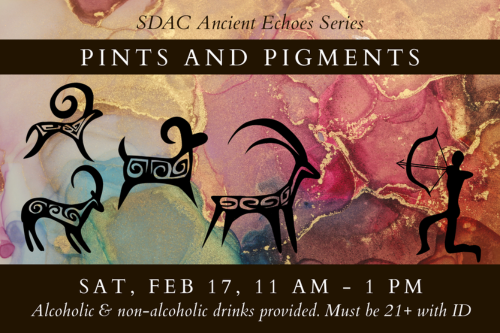 Ancient Echoes: Pints and Pigments
Ancient Echoes: Pints and Pigments
The archaeological record contains a vast amount of art sites located everywhere on the globe that Homo sapiens have travelled to. It has been recently discovered that rock art paintings in the Maltravieso caves in Cáceres, Spain date to between 100,000-75,000 BP, making them the oldest on earth yet discovered. In Chauvet cave in France, more than 400 animals painted in rich red ochre and charcoal hues date to 35,000 BP, and in Brazil’s Serra da Capivara National Park, hundreds of Ice Age mega fauna and handprints are painted in ochre and date to 37,000 BP. In all these early sites, there are three consistent mineral-based pigments: red, black, and white.
In this first installment of our Ancient Echoes series, you’ll make art the ancient way! Using natural pigments and a little human creativity, you’ll produce a one-of-a-kind paleolithic art piece (no cave required).
All art materials will be provided. Tickets include two drinks per person (alcoholic and non-alcoholic options available) and light refreshments. This event is 21+. Registration is limited to 16 participants.
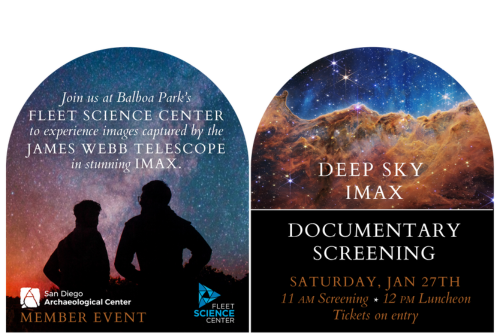 Members Only: Deep Sky Screening at the Fleet Science Center
Members Only: Deep Sky Screening at the Fleet Science Center
SDAC Members are invited to visit Balboa Park’s Fleet Science Center for a free screening of their Deep Sky IMAX documentary on the James Webb Telescope and its discoveries. Join us afterwards for a luncheon to meet other members, discuss the telescope incredible images, and wonder at recent advances in the sciences.
Advance registration required. Space is limited to 25 guests. This event is open to current SDAC members at all levels. If your membership has lapsed, you will be asked to renew in order to attend.
The Fleet Science Center is on a mission to realize a San Diego where everyone is connected by the power of science to create a better future. They are a community-focused countywide organization that collaborates with educators, scientific organizations, community leaders and champions of a-ha moments.
The Skeletons of La Consentida, Oaxaca, Mexico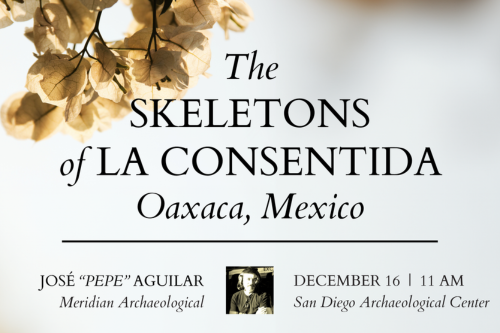
Join us for an in-person lecture with bioarchaeologist José “Pepe” Aguilar. Twelve burials, comprising 14 individuals, were excavated from an Early Formative Period (1950–1525 BC) site called La Consentida, in Oaxaca, Mexico in 2009 and in 2012. These burials were later analyzed in 2012 and 2019. Collectively, they represent the earliest formal cemetery in the Mesoamerican west coast. Note: this presentation will show photographs of human skeletal remains.
Pepe Aguilar is a San Diego-based archaeologist with a broad range of archaeological experience, including academic and contract archaeological surveying, monitoring, GIS, excavation, and report writing. His many specialties include archaeoastronomy, human skeletal analysis, mortuary practices, lithics, ceramics, and historic archaeology.
Mr. Aguilar has taught as adjunct professor at San Diego City College, Southwestern College, and San Diego State University. His teaching curriculum over the last 12 years has included introduction to archaeology, physical anthropology, physical anthropology laboratory, archaeological field methods, archaeological artifact analysis, cultural anthropology, and the anthropology of magic, witchcraft, and religion.
 Sip & Sketch Holiday Art Class
Sip & Sketch Holiday Art Class
Sip, sketch, and color at our holiday art class with archaeological illustrator Donna Walker. Learn how to draw the native plant Toyon Berry, also known as California Holly, then color your drawing with Prismacolor, an oil-based color pencil that blends and looks like a watercolor painting when you’ve finished. You’ll learn techniques that will give your objects depth and definition – gone will be the flat-looking images, yours will look 3-D! Then turn your drawing into a personalized holiday card for friends and family!
All art supplies will be provided. Tickets include two drinks per person (alcoholic and non-alcoholic options available) and light refreshments. This event is 21+.
Donna Walker is an artist and archaeological illustrator based in Valley Center, California. Recently, she has worked on several projects for the Anthropology Department at UC San Diego, illustrating Neolithic, Chalcolithic, and Bronze Age ceramics from Israel and Jordan.
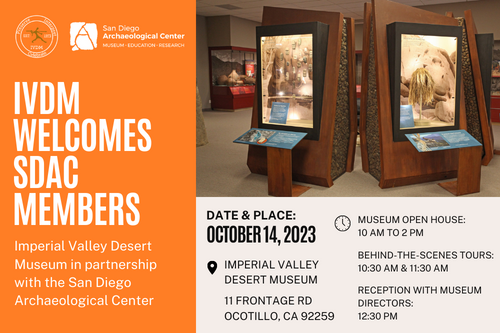 Members Only: Visit to the Imperial Valley Desert Museum
Members Only: Visit to the Imperial Valley Desert Museum
SDAC Members, join us for an open house, behind-the-scenes tours, and a reception at the Imperial Valley Desert Museum. Members are invited to go behind the scenes with IVDM Staff to learn about their exhibits, curation and collection spaces encompassing 10 million years of regional and local history! Following morning tours, SDAC Members are welcome to join IVDM Executive Director Kristin O’Lear and SDAC Executive Director Stephanie Sandoval for wine and hors d’oeurves. Under IVDM’s awning overlooking the beautiful Yuha Desert, they will discuss their organizations’ mission, current work, and future projects!
The Imperial Valley Desert Museum is a new facility in the heart of the Yuha Desert housing Indigenous and historic artifacts found within the Imperial Valley and surrounding region. Opening a new museum in the twenty-first century, we do not want to be seen as an exhibit within four walls, but to engage and interact outside of the limitations of the “box” – both metaphorically and physically.
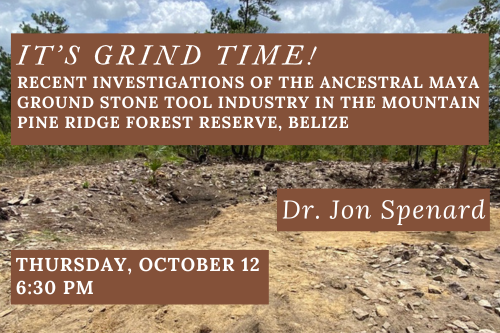 It’s Grind Time! Recent Investigations of the Ancestral Maya Ground Stone Tool Industry in the Mountain Pine Ridge Forest Reserve, Belize
It’s Grind Time! Recent Investigations of the Ancestral Maya Ground Stone Tool Industry in the Mountain Pine Ridge Forest Reserve, Belize
While conducting opportunistic regional survey in summer 2022 in the Mountain Pine Ridge Forest Reserve, Belize, Dr. Jon Spenard’s Rio Frio Regional Archaeological Project was informed of a series of granitic rock debitage piles nearby. Investigations revealed them to be ancestral Maya quarries and ground stone tool workshops, the first of their kind recorded anywhere in the Maya region. Naming the site the Buffalo Hill Quarries, the project mapped over a dozen extraction features (quarry pits and cut faces) surrounded by debitage piles spread over an area of approximately 16 hectares (40 acres). The site continued, but time did not permit its full documentation. Noted throughout the mapped area were dozens of production tools and discarded objects in various stages of reduction. Aided by data from an aerial LiDAR survey of the region, the project returned in summer 2023 to finish mapping the site and conduct test excavations on an extraction locus to investigate ancestral Maya quarrying methods and techniques. In this talk, Dr. Spenard will present the results of those two field seasons, introduce more results from the LiDAR survey, and discuss the next stages of the project, including examining who the quarry workers were and how their products may have been distributed.
Dr. Jon Spenard is an Associate Professor of Anthropology at Cal State San Marcos. He joined the department in 2016 after receiving his Ph.D. from UC Riverside in 2014 and his MA from Florida State University in 2007. Dr. Spenard has been conducting research on ancestral Maya society for over 25 years with a focus on ritual landscapes, particularly the ceremonial cave use in Belize, Guatemala, and Mexico. After joining CSUSM, he started the Rio Frio Regional Archaeological Project in 2018 to study the Maya presence in Mountain Pine Ridge Forest Reserve in central western Belize starting with the Rio Frio Caves. Over the course of the next two field seasons, the project unexpectedly grew in scope to include settlement survey and now a granitic rock extraction and ground stone implement crafting industry.
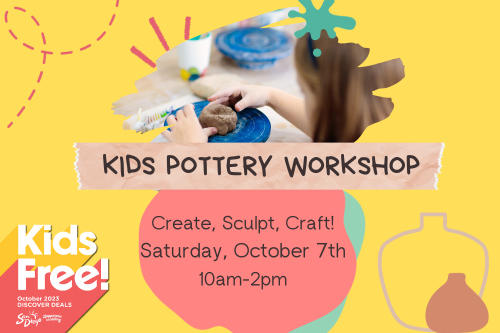 Kids Pottery Workshop
Kids Pottery Workshop
Calling all Junior Archaeologists! Get creative this October! Join us for a pottery workshop and museum open house. Create your own piece of pottery to take home with you. Journey through the museum on a family-friendly Archaeology Quest. Use your excavation skills to uncover the past, then examine and record your findings in our Field Lab – just like a real archaeologist!
Museum admission and pottery workshop are free for kids 12 and under. Adult museum admission: Pay what you wish (suggested $5/person).
Can’t make the date? Throughout October, you can present your Kids Free San Diego coupon to receive free admission to the Center and a take-home pottery kit for kids 12 and under. To participate, visit the San Diego Museum Council website to print or download your coupon. Then present it when you visit the Center to receive free admission and pottery kits for up to two children (12 and under) with one full-price paid adult ($5+). Limit 1 pottery kit per child.
 More Than Just Food. More Than Just Faunal Remains. Ethnozoology of the Kumeyaay People
More Than Just Food. More Than Just Faunal Remains. Ethnozoology of the Kumeyaay People
For the Kumeyaay people of San Diego County, animals, birds, insects, and other creatures hold a special place in the cosmos and played a variety of important roles. Some were involved in the creation, they can be whimsical, they can avenge, they can heal, and animals with certain powers can shift shapes and shimmer in the firelight. Their embodiment is not always easily visualized because some creatures, large and small, exist in worlds not always seen by most humans, and rarely acknowledged by archaeologists. For many of the native people, there was a time when animals were actually human. In the mythic, ancient time what we now know as humans, or more correctly as mortals, did not exist. The world was inhabited by animals and by animals who were humans but not mortals—these were the Early People and some creatures could embody traits of what came to be known as the mortal humans and animals. Only later in time did the separation grow between animals and humans, and at that time the humans became mortal.
This presentation will provide an analysis and discussion of the role and place of non-human creatures within the world and cosmos of the Kumeyaay people of San Diego County. The various creatures are of the land, the ocean, the lakes, and the sky—they are not bound to soil as are most humans. The role of animals in the native world is multi-faceted but often overlooked. Serving as a food source (such as deer) does not preclude the animal from having spiritual powers or from having special attributes. With few exceptions, animals small and large, powerful and meek, on the ground or in the sky, appear as a near constant in the native world.
Richard Carrico, writer, anthropologist, and educator grew up in San Diego and has always felt close ties to the land and its people—past and present. Richard is a U.S Army veteran. He is a lecturer in the Department of American Indian Studies at San Diego State University and lives in Warner Springs—the home of the Cupeño people. He is a well-respected scholar, public speaker, and researcher who has made significant contributions to our understanding of local Native American culture. His primary area of research is the Indian people of southern California and northern Mexico followed closely by the Spanish colonial period in San Diego County.
In addition to more than 30 publications in professional journals including the Journal of California and Great Basin Anthropology, the Pacific Coast Archaeological Society Quarterly, the California Mission Studies Boletin, and the Journal of San Diego History, Richard is the author of History of Wines and Wineries of San Diego County (2nd Edition 2023); Images of America Series: Ramona, and other books including the revised Strangers in a Stolen Land: The Indians of San Diego County from Prehistory to the New Deal (2014); and San Diego’s Ghosts and Hauntings. Beyond the academic realm Richard has authored historically or archaeologically based articles for the San Diego Reader, San Diego Union, California Magazine, Ranch and Coast Magazine, San Diego Home & Garden, and other popular magazines. He also has authored stand-alone chapters in four academic books.
Richard currently serves on the Board of Directors for the Imperial Valley Desert Museum, is past Southern Vice President of the SCA, and was recently presented with the prestigious Norman Neuerburg Award for Outstanding Contributions Towards the Study and Preservation of California’s Missions, Presidios, and Ranchos.
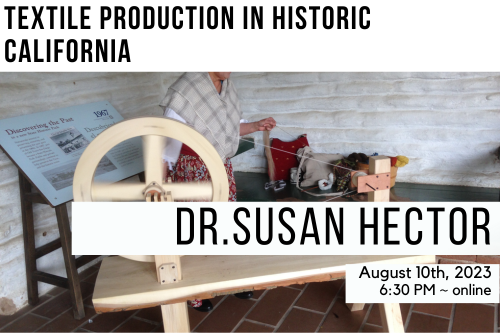 Textile Production in Historic California
Textile Production in Historic California
Spanish and Mexican textile traditions spread throughout what is now California when presidios (military forts), missions (churches with supporting industries), ranchos (settlements focused on grazing cattle and sheep), and pueblos (towns) were established in the late 1700s. Spinning wheels and looms were built for every location. Primary documents describe how the Spanish and Mexican governments promoted the production of wool and cotton fabric, critical to the survival of populations in these remote locations. In particular, blankets made of local Churro wool were important trade items and were made in the thousands every year. Unfortunately, few fragments of historic textiles from this period exist.
As an archaeologist and fiber craftsperson, Susan Hector decided to research historic period textiles in California and then create fabrics for use in Old Town San Diego State Historic Park as interpretive and museum objects. Starting in the early 1820s, retired soldiers and their families moved from the nearby Presidio to what is now Old Town San Diego. These families represented what is often referred to as the Californio culture. As the town grew, the women combined Native, Spanish, and American lifeways to make this period of American history one of our most diverse and culturally significant. This diversity is reflected in the textile traditions of the period before California became a territory and then a state.
This presentation will focus on cotton and wool textiles made in San Diego during the historic period and demonstrate how the continued production and use of these fabrics represented the diversity of cultures in Southern California at the time and the persistence of traditional methods of production. Susan will show examples including her interpretation of Jerga, Sabanilla, and Bayeta wool textiles. She will also share the results of her research on the quilt made by Juana Machado c. 1850 and curated at the San Diego History Center.
Dr. Susan Hector received her M.A. and Ph.D. from UCLA in Anthropology, and spent her career as an archaeologist and environmental project manager. Dr. Hector has received many awards, including the Lifetime Achievement Award from the Society for California Archaeology and the Excellence in Historic Preservation Award from the National Society Daughters of the American Revolution. Her work in historic preservation has been honored with 3 Governor’s Awards. She co-authored SB 1034, which amended the California Environmental Quality Act to add penalties for damage to cultural resources on public lands. In her retirement she serves on several nonprofit and corporate boards, and is President of the Center for Research in Traditional Culture of the Americas. She recently served as the Historian for the San Diego Chapter of the National Society Daughters of the American Revolution, and volunteers in Old Town San Diego State Historic Park and at the House of Scotland, Balboa Park.
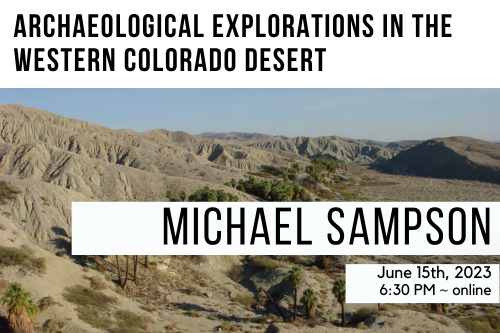 Archaeological Explorations in the Western Colorado Desert
Archaeological Explorations in the Western Colorado Desert
This presentation discusses the results of archaeological studies within the western Colorado Desert of Southern California over the past 100 years. The region represents the traditional lands of the Cahuilla, Kumeyaay (Ipai and Tipai), and Kwaaymii. Malcolm Rogers worked in the western Colorado Desert during the 1920s and 1930s and made important observations about pictographs, petroglyphs, geoglyphs, cleared circles, trails, house remains, and other cultural remains throughout the region. A summation of results and a commentary of the major excavation projects in the study area from the 1950s through the 2000s are also offered, as well as the results of certain site survey projects. Michael Sampson’s observations about site survey data within this region will consist primarily of the cleared circle sites and similar sites, as well as certain occupation sites and food processing sites. The archaeological remains of this study area predominately date to the Late Prehistoric Period and early historic period; evidence of cultural remains from the Archaic Period is relatively sparse. However, the Archaic Period is well represented at Indian Hill Rockshelter, a site that will be discussed.
The archaeological data from the study area reflect rich, long-held cultural practices that seem consistent with ethnographic accounts and indicate people with strong ties to these lands. Mr. Sampson’s research demonstrates that the Indigenous people of the region viewed their land holistically and chose places for use due to a favorable geographic setting, the presence of certain natural resources, and an inherent spiritual nature in specific landscape features and particular locations. The desert also possesses the capacity to inspire, to evoke memories in oral traditions, and otherwise promote knowledge and well-being.
Michael Sampson is a retired California State Parks archaeologist; in his career, he worked throughout the state but primarily in Southern California. His research interests include California Archaeology (in particular, the Colorado Desert and local mountains), stone tool technology and function, ceramic artifacts, traditional fiber technology, paleoenvironmental reconstruction, California red wines, and others. Michael has a BA in Anthropology from CSU, Northridge and a MA in Anthropology from Washington State University. He is co-director of a California non-profit research organization, Center for Research in Traditional Culture of the Americas. Michael coauthored the California Archaeological Resources Protection Act with Dr. Susan Hector for which they were awarded a Governor’s Historic Preservation Award in 2011. Michael was awarded an Excellence in Cultural Resource Management Award by the Society for California Archaeology in 2013. In 2016, Michael was given the Award of Honor by the San Diego Congress of History for his contributions to the preservation of history in our region. Michael is also a long-time volunteer in Old Town San Diego State Historic Park.
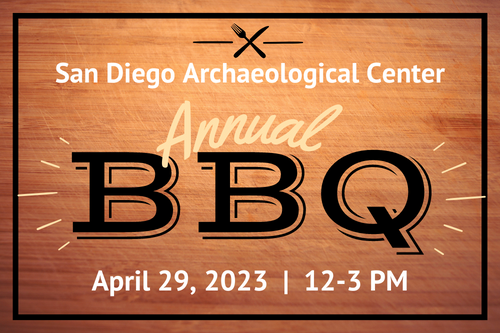 Annual BBQ
Annual BBQ
Join us for an afternoon of food, amusement, and music in support of the Center. Proceeds from the BBQ support preservation of archaeological collections, school field trips and programs, lectures, workshops, and museum exhibits.
Enjoy pulled pork sandwiches on brioche buns with coleslaw and mac and cheese from local restaurant H Brothers and ice-cold beer from our open bar. Vegetarian falafel wraps also will be available upon request (please indicate in comments when purchasing BBQ tickets).
Hear live classic rock and country music performed by Head First, featuring local archaeologist Dr. Timothy Gross. Test your aim with our atlatl throw then take a selfie in our archaeology-themed photo booth.
Bid on unique items at the Silent Auction and enter the Opportunity Drawing for a chance to win a two-night stay at an Idyllwild cabin. Spin our Member Prize Wheel for a chance to win SDAC merchandise, museum passes, and more (SDAC Members only).
Meet with cultural resource management (CRM), government, and academic archaeologists to learn about working in the field of archaeology. The Center will also present the Golden Trowel Award for excellence in archaeology.
 The Coastal Maritime Migration Hypothesis
The Coastal Maritime Migration Hypothesis
The peopling of the Americas during the late Pleistocene has been an enduring topic of archaeological interest for over a century. It was long argued that Clovis big game hunters entered North America through an ice-free corridor. Alternatively, Knut Fladmark in 1979 argued that they may have traversed by foot along the coast. In recent decades it has been argued that Paleoindians, who occupied the Northern Channel Islands around 13,000 years ago, may have employed sophisticated watercraft to migrate down the coast.
In the last few years, Mark Sutton has argued that if competent mariners originally occupied the Northern Channel Islands, then the Southern Channel Islands would have been occupied shortly thereafter. However, this did not take place until four millennia later. To explore these hypotheses, Jim Cassidy proposes that universal features of watercraft design and construction may be employed to inform on the technological requirements of seafarers to colonize the Southern Channel Islands during the early Holocene.
Dr. Jim Cassidy completed his Ph.D. in anthropological archaeology at the University of California Santa Barbara, specializing in the prehistory of maritime societies. He has conducted field research on the California Channel Islands, the Maritime Region of the Russian Far East, and Baja California. He co-authored the book California Maritime Prehistory and co-edited a book on the Maritime Prehistory of Northeast Asia, which was published in 2022.
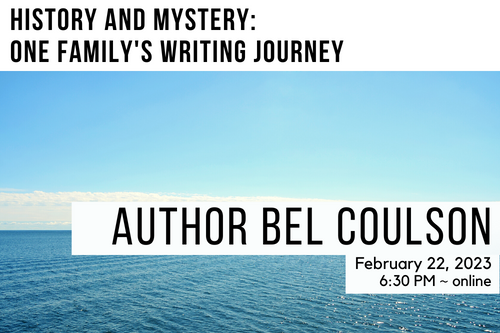 History & Mystery: One Family’s Writing Journey
History & Mystery: One Family’s Writing Journey
The three authors will discuss their historical novel The Casebook of Qing and Xmucane, wherein Qing, a young officer in the Chinese Imperial Navy journeys to Mexico with the fleet of Admiral Zheng He in the early 15th century of the Roman calendar. He meets Xmucane, an elderly shamaness living on the outskirts of the Tarascan empire. Together they form a formidable pair of investigators, solving crimes large and small.
The process of writing historical fiction, the characters and themes of the story, and the joys and complications of being a team of authors who have known each other for a long time will be discussed.
B. E. L. Coulson is a family writing trio living in Dana Point, California, who enjoyed crafting this book together. Brendan Coulson is a English as a Second Language teacher. He has taught students of all ages and backgrounds in three, soon to be four, different countries. Ed Coulson is a professor of real estate and economics. He is also a two-time champion on the TV game show Jeopardy! Linda Coulson is a volunteer in the lab of the San Diego Archeological Center. She works with both historic and prehistoric materials, including 19th and early 20th century ceramics and artifacts of the Kumeyaay people of the San Diego area.
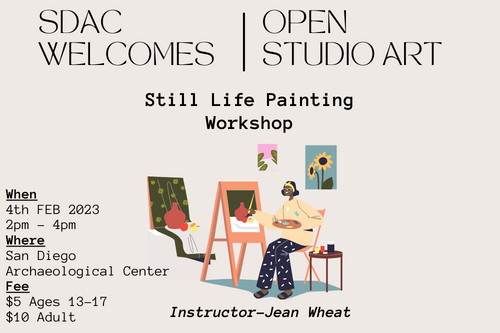 Still Life Painting Workshop
Still Life Painting Workshop
A historic vase, a pottery vessel, a historic ink bottle placed on a table — though seemingly simple, everyday artifacts are still exciting to an artist’s brush. Create your own still life painting inspired by local artifacts from the Center’s collections. Materials will be provided.
Jean C. Wheat was born in Harlem, New York City. Her first one woman show was on the underside of her grandmother’s kitchen table when she was three years old. Through the years Jean’s passion for creative expression has grown from underneath that kitchen table to hanging on walls around the world and public art commissions in the United States.
In 1989 Jean received a scholarship to study fine art at the University of Madrid, Spain. Jean taught African American Art History for sixteen yearn at San Diego Community College.
For the past 20 years Jean has been a volunteer grandparent to foster children at San Pasqual Academy in California where she shares her life and art experiences with the students and others.
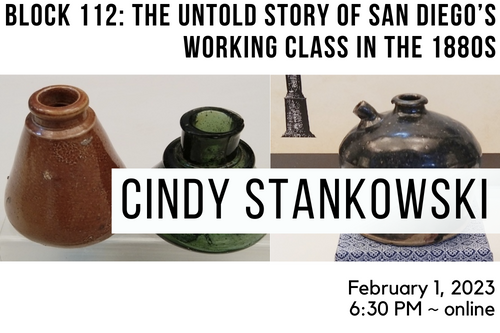 Block 112: The Untold Story of San Diego’s Working Class in the 1880s
Block 112: The Untold Story of San Diego’s Working Class in the 1880s
Archaeology provides evidence of those who are under-represented in the official version of history. Often times, the recorded account of history is about rich, influential men and wars. What about the women, children, immigrants, the poor, and the different?
Block 112 in Downtown San Diego reflected the same urban diversity that was typical of large Eastern cities. Of the 50 residents, 16 were white or African American citizens. The other 34 were immigrants and ethnic minorities—Chinese laundrymen, a Mexican mill hand, a French gunsmith, a German day-laborer, a Welsh musician, a Japanese lunch man, and an Irish baker. This presentation reveals clues about their everyday lives, ambitions, and lifestyle.
Cindy Stankowski’s personal commitment is to continue to have a positive impact in the community by making new ideas and information accessible in the museum setting. Ms. Stankowski received a Bachelor’s degree summa cum laude in Anthropology from San Diego State University and a Master’s degree in Museum Studies from San Francisco State University. She has been with the San Diego Archaeological Center since 1996, leading the effort to preserve our archaeological legacy. Ms. Stankowski also seeks new and innovative ways for the public to connect with the past, including exhibits, seminars, and school presentations.
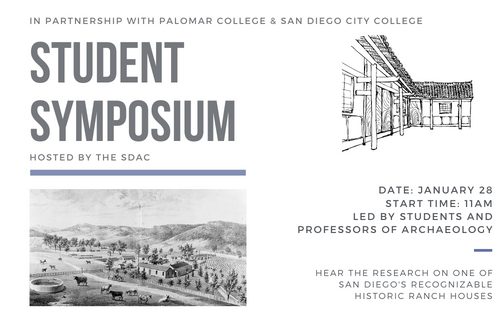 Student Symposium
Student Symposium
Join us at the Center to hear students present their research on one of San Diego’s recognizable historic ranch houses. The Los Peñasquitos Ranch House was constructed in 1823 by Francisco María Ruiz, the recipient of the first Mexican land grant in San Diego County. Ongoing archaeological digs take place on site, revealing remnants of early civilization and the history of human habitation. Located in the Los Peñasquitos Canyon, the adobe continues to be visited today and stands as a reflection of San Diego’s history. Poster presentations will cover faunal analysis, the ammunitions of the time period, historic ceramics, animal husbandry, and more.
The Palomar Archaeology Program, with its A.A. Degree, A.A.T emphasis, and Certificate of Achievement, is oriented toward three audiences: students who seek immediate or eventual employment in Cultural Resource Management as an excavator, surveyor, lab assistant, and/or cartographer; students who wish to gain valuable technical field and lab skills along the way toward a B.A. or advanced degree in Anthropology/Archaeology; and interested members of the public who would like to work on archaeological projects as an avocation and desire some training, e.g., the Excavation Certificate. In addition to standard excavation, surveying, and laboratory skills, the program offers training in database management, computer aided drafting (AutoCad), GPS, and GIS (Geographic Information Systems).
The San Diego City College Anthropology Program has been developed to provide the student with a broad perspective of human biological and cultural origins and change which prepares the student for transfer to a four-year institution. It also offers a limited course curriculum in archaeology. A certificate of achievement is available for the student who has an interest in the recovery, identification, and analysis of prehistoric and early historic artifacts related to archaeological research projects.
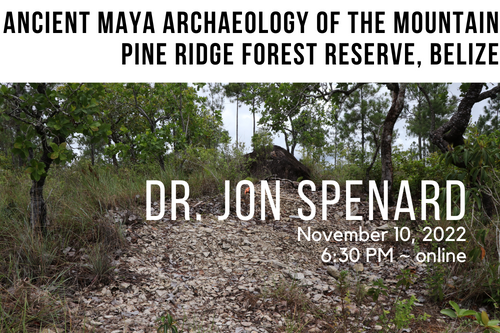 Ancient Maya Archaeology of the Mountain Pine Ridge Forest Reserve, Belize
Ancient Maya Archaeology of the Mountain Pine Ridge Forest Reserve, Belize
The Mountain Pine Ridge Forest Reserve in central Belize is a unique landscape in the Maya lowlands. It is largely defined by a series of granitic upwellings that produce nutrient leached soils that are poor for farming, but the region is bordered by cave-filled limestone hills. Because of the poor soils, the ancient Maya were thought to have never lived there, but it was the source of many important economic resources, especially granite for making grinding stones. Research in 1928 demonstrated that the ancient Maya used at least some of the caves for ritual purposes, but where the participants came from remains unknown. In 2018, Dr. Jon Spenard initiated his Rio Frio Regional Archaeological Project (RiFRAP) to address that question. Either the caves were long-distance pilgrimage destinations, or there were here-to-fore yet undocumented Maya sites in the region. The answer is the latter. In this talk, Spenard presents on the recently documented ancient Maya site of Nohoch Batsó and the nearby Buffalo Hill quarries, a multi-component granitic rock quarry and ground stone tool manufactory.
Jon Spenard is Associate Professor of Anthropology at California State University San Marcos. He earned his Ph.D. from University of California Riverside and his M.A. from Florida State University. He has conducted social landscape archaeological research in Belize, Guatemala, and Mexico where he has largely focused on ancient Maya cave ritual practices. In 2018, he started his Rio Frio Regional Archaeological Project, or RiFRAP, the first long-term study of the Mountain Pine Ridge in Belize. The initial focus of that project was several cave sites in the Rio Frio valley that were documented 90 years earlier but not studied since. Since its inception, the scope of the project has expanded to a broader study of the many ways past Maya people interacted and lived in a landscape unique in the Maya lowlands.
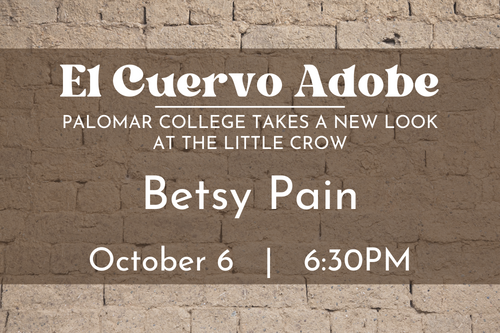 El Cuervo Adobe: Palomar College Takes a New Look at the Little Crow
El Cuervo Adobe: Palomar College Takes a New Look at the Little Crow
The Ruiz-Alvarado Adobe, known as El Cuervo, is located at the west end of the Los Peñaquitos Canyon Preserve. Like the Rancho Peñasquitos Adobe to the east, both structures are located on land owned by Francisco Maria Ruiz. They are some of the oldest existing adobes in Southern California and are listed on the National Register of Historic Places. While much is known about the Rancho Peñasquitos Adobe, not much is known about El Cuervo.
This discussion explores the occupant chronology of the adobe as well as a review of the only archaeological field excavation to have been conducted by San Diego State University in 1982 and 1983. Palomar College has been given limited access to the adobe and surrounding area to map and record the still existing features on the property. The goal is to add to the story of the canyon through boots-on-the-ground and drone surveys, GPS data point collection and mapping. No excavation of El Cuervo will take place as a result of the permit.
Betsy Pain is an Assistant Professor of Anthropology at Palomar College. She is also the Archaeology Program Coordinator. Since 2012, Betsy has been co-teaching Palomar College’s hands-on excavation class at Rancho Penasquitos Adobe with her colleague Jim Eighmey.
As with Palomar College, all of Betsy’s field experiences have been academically based. As an undergraduate at UCLA, she had the opportunity to excavate the slave quarters on the site of an old sugar plantation in Jamaica. This was a shift away from focusing on the landowners and toward wanting to understand more about the people who were forced to work there.
While in graduate school at California State University, Northridge, Betsy was the field director for an NSF funded field school that took place at San Elijo Lagoon here in San Diego. The project was a collaborative effort between UCSD and ASM and Affiliates. As a result of her work on the project, Betsy chose to do her Master’s thesis on the temporal shellfish use at the lagoon spanning the Holocene.
With experience in both historic and prehistoric archaeology, Betsy’s goal is to add to the history of the preserve by highlighting the connection between the two adobes and to help in the interpretation of the people who have lived in the canyon over the last 10,000 years.
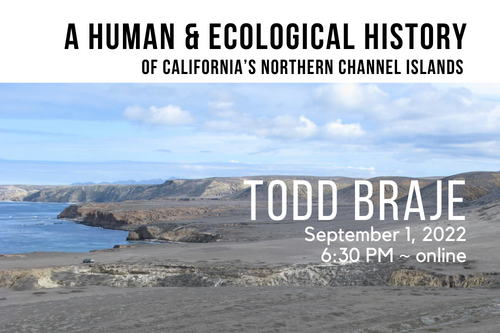 A Human & Ecological History of California’s Northern Channel Islands
A Human & Ecological History of California’s Northern Channel Islands
California’s Northern Channel Islands, sometimes called the American Galápagos, are often celebrated as a trip back in time where tourists can view glimpses of California prior to modern development. The islands are sometimes portrayed as frozen moments in history where ecosystems developed in virtual isolation for tens of thousands of years. For at least 13,000 years, however, the Chumash and their ancestors occupied the islands, leaving behind one of the longest and best preserved archaeological records in the Americas. From ephemeral hunting and gathering camps to densely populated coastal villages and Euro-American and Chinese historical sites, archaeologists have studied Channel Island environments and material culture records for over 100 years, piecing together a fascinating story of initial settlement by mobile hunter-gatherers to the development of one of the world’s most complex hunter-gatherer societies. For more than 10,000 years, the Chumash survived dramatic changes to their land- and seascapes, climatic fluctuations, and ever-evolving social and cultural developments. Today, the lessons of Channel Islands history can act as a guide for building sustainable strategies. The resilience of the Chumash and Channel Island ecosystems provides a compelling story of hope for a world increasingly threatened by climate change, rising seas, declining biodiversity, and geopolitical instability.
Todd J. Braje is Professor and Department Chair of Anthropology at San Diego State University, where he conducts research on the archaeology and historical ecology of maritime hunter-gatherer-fishers and maritime migrations. He has published over 100 academic articles, and his latest book is available from Roman & Littlefield and titled Islands through Time: A Human and Ecological History of the Northern Channel Islands.
 Ashes from Ashes: Archaeologists & Forensic Dogs Recovering Lost Human Remains
Ashes from Ashes: Archaeologists & Forensic Dogs Recovering Lost Human Remains
In this lecture, archaeologist Natalie Brodie will discuss current efforts to recover previously cremated human remains following massive wild fires. Volunteer archaeologists with the Alta Heritage Foundation, a California non-profit organization, have been paired with trained forensic dogs and handlers to search for the cremated remains of loved ones in the aftermath, providing some hope and healing to those who thought their family members were lost. Ms. Brodie will discuss the process used by the archaeologists, the remarkable results of the effort, and the value of the archaeological process for remains recovery. Note: this presentation will show photographs of cremated human remains.
Natalie Brodie is a Senior Archaeologist at AECOM, and has been a professional archaeologist for 20 years, working her way around southern California. In her free time, she likes baking pastries, playing with cats, hugging trees, and vintage social dancing.
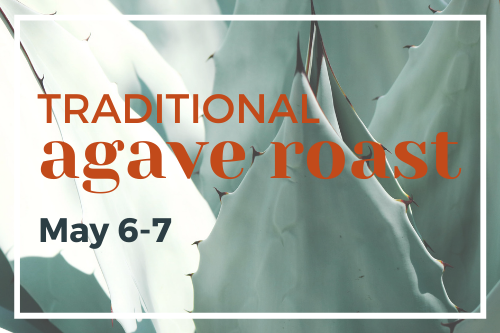 Traditional Agave Roast
Traditional Agave Roast
Center Members are invited to join Stan Rodriguez (Kumeyaay – Iipay, Santa Ysabel) at the La Posta Indian Reservation for a traditional Agave Roast.
Friday, May 6, 10 AM to 1 PM: Watch how the pit oven is prepared and agave hearts are made ready for roasting.
Saturday, May 7, 1 to 5 PM: Enjoy Bird Singing and a pit roasting demonstration as well as taste and learn about the many uses of the agave plant. Other native food provided by Grey Wolf Monitoring.
Thank you to La Posta Band of Mission Indians, Stan Rodriguez, Ed Mercado (Kumeyaay, La Posta), Grey Wolf Monitoring, and Brian Williams of ASM Affiliates for making this event possible.
Stan Rodriguez (Kumeyaay – Iipay, Santa Ysabel) learned from his Grandmother and other Kumeyaay Elders the methods and culture. Stan has an MA in Human Behavior and received his doctorate degree at UCSD. He is a Board Member and Instructor at the Kumeyaay Community College.
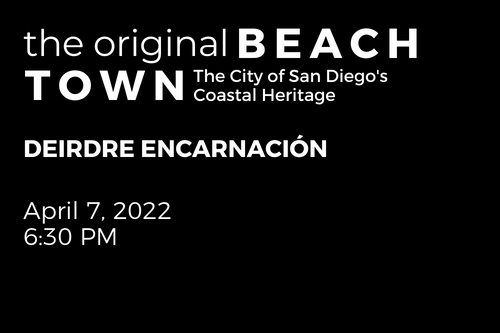 The Original Beach Town: The City of San Diego’s Coastal Heritage
The Original Beach Town: The City of San Diego’s Coastal Heritage
Utilizing studies from a range of disciplines, researcher and ocean enthusiast Deirdre Encarnación recounts how the Native people of San Diego utilized the seasonal and year-round resource base available along the coast. Archaeological data and analysis is combined with oral history, ethnographic reports, historical accounts, geologic maps, and ecological studies to tell the story of the first people to call the beaches and shores of San Diego home.
Deirdre Encarnación earned both her B.A. and her Master’s degree at San Diego State University, studying anthropology and biology. Most recently, she earned her Certificate of Specialization in Kumeyaay Studies from Kumeyaay Community College/Cuyamaca College, with a focus on Native land management and language. She has worked in cultural resource management throughout Southern California for the past sixteen years, and as an advocate for the preservation of cultural sites for a non-profit organization on the island of Kaua’i since 2016.
 Forensic Analysis of Moai Transport
Forensic Analysis of Moai Transport
Rapa Nui (Easter Island) Moai weighing tens of tons were quarried of Rano Raraku tuff and transported kilometers across the island. Researchers have proposed at least five different methods for achieving this re-location. However, no previous studies have considered the structural engineering limitations of the moai transport methods themselves. This paper applies structural engineering analysis to the moai transport methods proposed by Heyerdahl, (Hunt&Lippo, Pavel), Mulloy, Love, and Van Tilburg.
A typical size moai was assumed for purposes of analysis. Moai were modeled as right circular cylinders. Structural analyses showed that four of the proposed transport methods were structurally sound. Erosive wear of the moai’s base during the “refrigerator walk” method could not be analyzed due to lack of erosive wear data. However, the bases of the moai studied do not show the qualitative wear one would expect from the “refrigerator walk”. It was found that palm tree trunks could support the requisite loads if multiple trunks were used at load points. Transport stability limits, i.e. moai static tipping limits, were established.
Dr. Frederick Best is a professor of engineering (retired) at Texas A&M University where he taught for 29 years. His degrees include BE in Mechanical Engineering, Manhattan College; MS and PhD Nuclear Engineering, Massachusetts Institute of Technology; Registered Professional Engineer (Inactive). The paper presented is the result of field work on Easter Island as approved by Ma’u Henua.
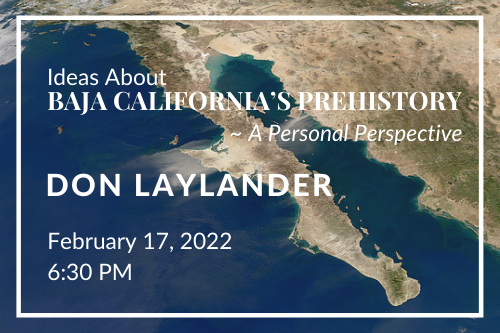 Ideas About Baja California’s Prehistory: A Personal Perspective
Ideas About Baja California’s Prehistory: A Personal Perspective
During the 40+ years Don Laylander has studied the enigmatic peninsula’s prehistory, our understanding of it has grown and evolved. He will discuss his views on where we stand now on some of the major issues in that story, including its chronology, complexity, continuity, and connections.
Don Laylander is an archaeologist who has retired from the California Department of Transportation and ASM Affiliates, Inc. In addition to participating in field investigations throughout Alta California, he has written about Baja California’s prehistory for more than four decades from a variety of perspectives, producing a master’s thesis at San Diego State University and more than four dozen articles touching on the subject from archaeological, historical, linguistic, and ethnographic perspectives.
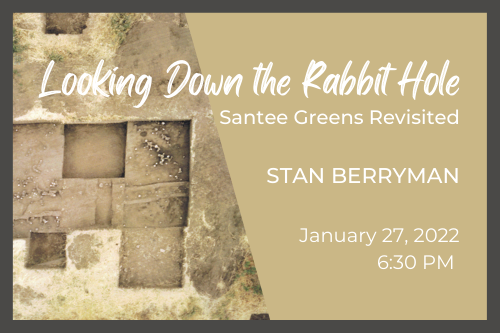 Looking Down the Rabbit Hole: Santee Greens Revisited
Looking Down the Rabbit Hole: Santee Greens Revisited
The site of Santee Greens aka Michagua, a Late Holocene village over 29,000 square meters, was originally radiocarbon dated in 1980 and 1981. It showed two occupation periods, AD 760 to AD 1030 and AD 1735 to AD 1890. With the help of the San Diego Archaeological Center, Dr. Stan Berryman was able to use modern C14 dating techniques on 23 charcoal samples. We now know the original dates leave something to be desired. With these “new” dates Dr. Berryman is revising our understanding of the work conducted by 40 archaeologists over a nearly three-year period. This is the story of 270 excavation units and 223,236 artifacts.
Dr. Berryman hopes that ultimately this work will aid in a better understanding of the people who lived at this site. In this presentation, he will discuss a project that was conducted before there was a sub discipline of archaeology called cultural resource management, then take a look at the wide range of artifacts recovered and how they relate to and are explained by the C14 dates. He will also present a couple of projectile point styles, in particular the Dos Cabezas double side notch, that are found throughout the Western U.S. under the name Temporal. Finally, C14 dates and changes within the site will be examined. Join us for a look down this rabbit hole that has been waiting 40 years for its story to be told.
Dr. Stan Berryman received a BA Anthropology at San Diego State University June 1970 and a PhD Archaeology from the University of Leicester July 2014. His career in archaeology has been primarily in Cultural Resource Management (CRM) with the first 23 years spent in the private sector. For the next 20 years, he worked in the government sector, managing resources and archaeological studies at Marine Corps Base Camp Pendleton, Cleveland National Forest, and ended the CRM part of his career in early 2016 at White Sands Missile Range in New Mexico. During these 40+ years, he had the pleasure of working with legends of California, especially his friend, mentor and sometime tormentor Emma Lou Davis.
Dr. Berryman has retired from CRM and has most recently been working at New Mexico State University (NMSU) as Affiliated Faculty assisting at the Cottonwood Spring Pueblo, South Diamond Pueblo, and Twin Pines Pueblo field schools. Currently, he is working on a NAGPRA grant from the Park Service with the NMSU Museum.
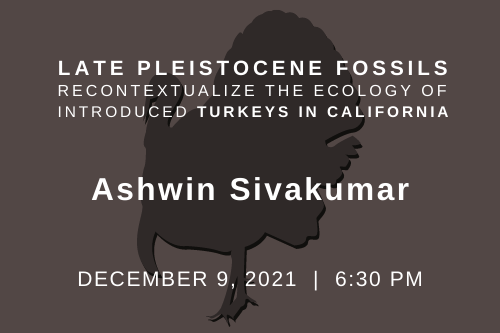 Late Pleistocene Fossils Recontextualize the Ecology of Introduced Turkeys in California
Late Pleistocene Fossils Recontextualize the Ecology of Introduced Turkeys in California
Biologists have proposed that we could resurrect the roles of extinct species in ecosystems by introducing closely-related surviving species. However, this idea—called “taxon substitution”—has never been intentionally tested on a large scale. California used to have a native turkey species, the California Turkey, that went extinct at the end of the last Ice Age. In the 20th century, a related species from the central and Eastern United States, the Wild Turkey, was introduced into California as hunting stock. Since then, the Wild Turkey has multiplied and spread all across the state. This study uses fossil and current occurrence data as well as climate information from the Pleistocene and present to try to determine if the extant Wild Turkey is occupying an ecological niche analogous to that of the extinct California Turkey. If true, this may be a case of an accidental large-scale taxon substitution and would suggest that the technique could be further investigated as a potential tool for wildlife conservation. This talk will be held on Zoom and is limited to 100 participants.
Ashwin Sivakumar is a high school senior at Flintridge Preparatory School at La Canada-Flintridge, CA. He is extremely interested in ecology, evolutionary biology, conservation, and advocacy. He has engaged in science research in these fields for several years, publishing two peer-reviewed papers and presenting his work in several international conferences. More details on his research and advocacy can be found at https://ahsivakumar.com.
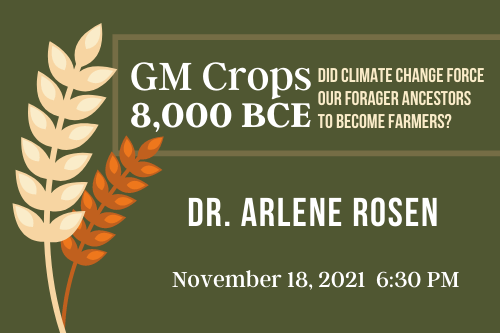 GM Crops 8000 BCE: Did Climate Change Force Our Forager Ancestors to Become Farmers?
GM Crops 8000 BCE: Did Climate Change Force Our Forager Ancestors to Become Farmers?
The beginning of agriculture was one of the most critical pivot points in the 300,000-year career of our species. It set the stage for rapid shifts in human (Homo sapiens) social, economic and political systems that led us to the complex societies we live in today. In the past few decades, many archaeologists have pointed to climate change as a prime mover which led us to shift from a two-million-year tradition (in the genus Homo) of foraging and hunting to farming in the past mere 10,000 years. But what actually was the role of climate change in the beginnings of cultivation? Was it really a solitary “prime mover” of economic change? Or were there other critical contingencies? In this lecture, Prof. Arlene Rosen explores the reasons for the origins of wheat and barley agriculture in Southwest Asia using her own data from the rare plant remains collected from sites of the last Hunter/Gatherer groups in that region.
Arlene M. Rosen is a Professor of Environmental Archaeology and Geoarchaeology in the Department of Anthropology at the University of Texas at Austin. She is working on human environmental relations during later prehistory and in early complex societies in the Levant, China, Mongolia, and New Mexico. She is the author of Civilizing Climate: Social Responses to Climate Change in the Ancient Near East (2007: Altamira Press), and numerous journal articles dealing with issues of human adaptations to climate change and human impact on the environment, published in issues of PNAS, PlosOne Current Anthropology, The Holocene, Journal of Anthropological Archaeology, and Quaternary International, among others. She recently organized an international workshop entitled “The Anthropocene in the Longue Durée”, which has since been published as a special issue of The Holocene in October 2015.
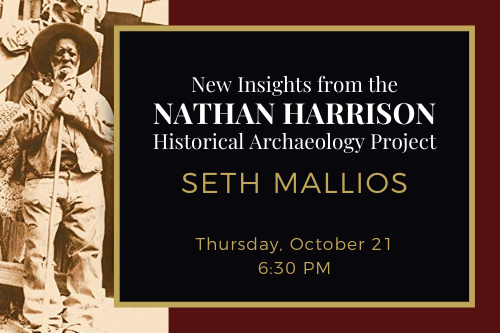 New Insights from the Nathan Harrison Historical Archaeology Project
New Insights from the Nathan Harrison Historical Archaeology Project
The 2021 summer field season at the Nathan Harrison site produced multiple stunning discoveries that furthered understanding into the life and legend of Palomar pioneer Nathan Harrison. San Diego State University professor and project director Seth Mallios will offer an overview of the field project, discuss the current San Diego History Center exhibit, and detail the site’s most recent finds. A single spectacular find from the midden answered one of the biggest debates regarding Harrison’s personal life.
Dr. Seth Mallios is Professor of Anthropology, University History Curator, and Director of the South Coastal Information Center at San Diego State University. An archaeologist, anthropologist, and historian, Professor Mallios received his BA from the University of California, Berkeley and his MA and PhD from the University of Virginia. Dr. Mallios previously served as Site Supervisor at the 1607 James Fort archaeological site in Jamestown, Virginia, the first permanent English settlement in the Americas. Since moving to San Diego in 2001, Professor Mallios has spearheaded six local research projects. Dr. Mallios has published ten books, dozens of articles, and garnered nearly $2 million in over 90 extramural grants, contracts, and awards.
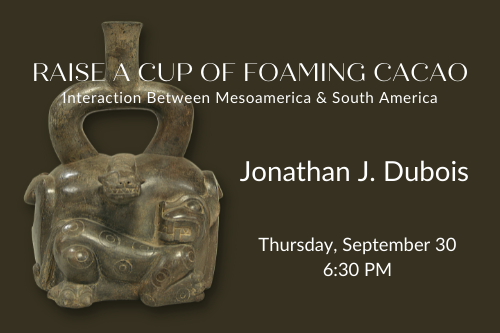 Raise a Cup of Foaming Cacao: Interaction Between Mesoamerica & South America
Raise a Cup of Foaming Cacao: Interaction Between Mesoamerica & South America
In this presentation, Dr. Jonathan J. Dubois will focus on cacao and the iconography associated with it in the Ancient Americas. Most of our knowledge about the practice of rituals involving the consumption of fermented cacao beverages comes from Mesoamerican ethnohistory and Classic Period (300-900 CE) iconography and epigraphy. Recent studies have demonstrated that cacao was likely domesticated in Northwestern South America at least a millennium before it came into use farther north. Dr. Dubois’ investigations have begun to demonstrate that imagery related to cacao in Mesoamerica also appears more than a millennium earlier in South America, during the Formative (1500-500 BCE). He will discuss the iconographic evidence from both regions and explore the implications of this evidence. Dr. Dubois will conclude with a discussion of an ethnohistoric model for what these earliest long-distance traders may have been – specialists in the ceremonies and traditions surrounding the plants and objects they were trading in.
Jonathan J. Dubois (Ph.D. UC Riverside 2017), adjunct professor at California State University San Bernardino, is a landscape archaeologist whose work lies at the intersection between symbolism, landscape, and social organization in past societies of Northwestern South America and Belize. He has conducted field work on the Central Coast, the Central Andes, and the Northwestern Amazon of Peru, as well as in the Rio Frio region of Belize. He documented rock art at more than 20 sites in the Central Andes, resulting in the dissertation Transformational Refractions of Social Messages in the Rock Art of Huánuco, Peru. He is co-director of Proyecto Arqueologico del Noroeste de America del Sur (PANOAS), which is focused on uncovering the interactions amongst peoples of Northwestern South America and longer-distance relationships between them and past peoples of Mesoamerica as evidenced through shared material practices and expressions of cosmological symbols in multiple archaeological media. This project is part of a larger, international cooperative effort, with Jon Spenard of CSU San Marcos, focused on better understanding the interregional interactions of pre-Columbian peoples of the Americas. He has recently had an article published in Cambridge Archaeology Journal titled Singa Transitional: Rock-Art Saywas Marking Boundaries of Identity in Huánuco, Peru.
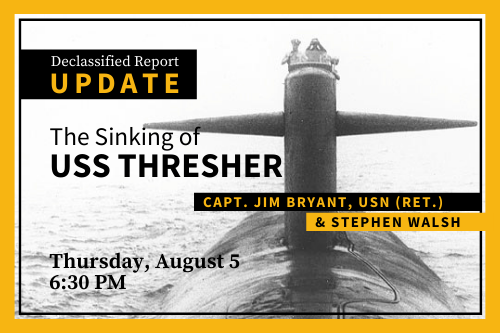 Declassified Report Update: The Sinking of the USS THRESHER
Declassified Report Update: The Sinking of the USS THRESHER
Captain Jim Bryant, USN (Ret.), a former commanding officer of a THRESHER Class nuclear powered submarine, and Stephen Walsh, a retired submarine naval architect, will discuss the most important details learned from recently declassified files, including the many factors that contributed to the first and worst nuclear submarine disaster. Fifty-eight years ago, USS THRESHER (SSN 593), the most advanced nuclear submarine of its time, imploded at a depth of 2,400 feet, claiming 129 lives. After disputing the Navy’s official report about this event, Capt. Bryant filed a lawsuit that succeeded in forcing the release of over 1,700 pages of testimony and 100 exhibits of redacted and declassified material.
Captain Jim Bryant received a Bachelor of Science degree from the U.S. Naval Academy and was commissioned an Ensign in 1971. Bryant was selected by Admiral Rickover for the naval nuclear propulsion training and subsequently served on five nuclear submarines that culminated with commanding USS GUARDFISH (SSN 612) from 1987-1990. Three of these submarines were homeported in San Diego, CA. During his 23-year career he participated in Cold War Missions in the Gulf of Aden; North, Norwegian, Bering and Arabian Seas, and the Seas of Japan and Okhotsk and assisted the Royal Navy during the Falklands War as a Staff Officer in London, UK. After a tour in the Pentagon he retired from the Navy in 1994 and started a small business. Bryant also researched the sinking of the nuclear submarines THRESHER and SCORPION.
In 2015 he returned to San Diego, took courses in Archeology and became a volunteer at the San Diego Archeological Center. His research on the loss of USS THRESHER (SN 593) found that the Navy’s version of the disaster was inaccurate and resulted in publications of several articles. In July 2019 he sued the Navy for information on THRESHER after his Freedom of Information Act request was ignored. The Judge ordered the Navy to start producing declassified material in February 2020, but due to COVID-19 the first batch of declassified material was released in September 2020.
Stephen T. Walsh is a retired GS-15 Civil Servant who worked for the U.S. Navy for nearly 39 years. Mr. Walsh started that career in February of 1978 by working as a Naval Architect at the Portsmouth Naval Shipyard (PNSY), working both submarine structures and submarine hydrostatics. He was the NAVSEA Task Leader for Hydrostatics for what became the USS SEAWOLF (SSN 21) Class Preliminary and Contract Design Phases as well as overseeing the hydrostatic parameters of new construction and in-service SSN and SSBN Submarines. In 1990, he became a Project Engineer in the NAVSEA (PMS395) DSSP Office (working Deep Submergence Vehicles (DSVs)) as well as on OE Projects. In July of 1994 he became an Assistant Program Manager (APM) in the same Deep Submergence Program Office, managing a number of Deep Submergence assets (e.g., Deep Submergence Vehicles (DSVs), NR-1, USS DOLPHIN (AGSS 555), a number of unmanned vehicles (UMV’s), and the U.S. Navy’s Submarine Escape, Survivability and Rescue – including the Deep Submergence Rescue Vehicles (DSRVs) and the previously mentioned SRCs. Later as an APM in NAVSEA (PMS399), Mr. Walsh oversaw the completion of the testing and subsequent delivery of the U.S. Navy Special Forces Sea, Air and Land (SEAL) Advanced SEAL Delivery System (ASDS), which was DSS-SOC Certified. Afterwards, while still in NAVSEA (PMS399), he managed the DSS-SOC Certified ‘In-service’ SEAL Dry Deck Shelter (DDS) Program and the integration of these assets, and other SEAL capabilities onto the USN SUBSAFE Certified 688 and 774 Class SSN’s and the 4 converted 726 Class SSGN Submarines. He completed his career in NAVSEA (PMS391) where he was the APM for U.S. Submarine Escape and Disabled Submarine (DISSUB) Personnel Survivability, retiring in early January of 2017. Mr. Walsh is the owner of Trident Acquisition Support, LLC, located in Laconia, NH, where he provides consulting support to various clients in the areas discussed above.
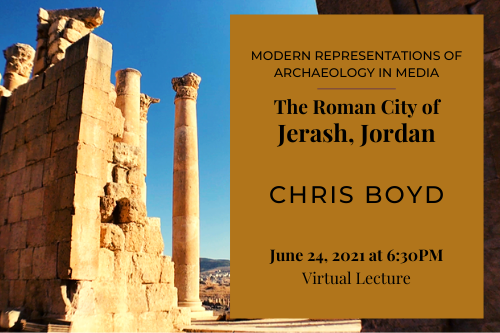 Modern Representations of Archaeology in Media: The Roman City of Jerash, Jordan
Modern Representations of Archaeology in Media: The Roman City of Jerash, Jordan
Documentary filmmaker Chris Boyd presents considerations on how archaeological material and concepts are presented to the general public through popular media, using an ongoing restoration project in Jerash, Jordan as a case study. Boyd discusses his background, and how he oriented his career toward independent film projects that cover archaeological topics. In highlighting his work in Jordan in 2019 for a joint archaeological project sponsored by the US State Department, Chris presents ways in which modern media — most importantly, short-form documentary work distributed online — is a crucial tool for disseminating academic archaeological work and educating the general public about its cultural value. Chris also considers ways in which archaeological projects around the world must utilize media as part of the new “Public Archaeology” focus, to maintain relevance in government policy-making and secure international funding.
Chris Boyd is a native of San Diego, California and attended film school at the University of Southern California, where he graduated with his B.F.A. in Writing for Screen and Television. In 2010, he completed an MA in Archaeology at Durham University in the UK. He found his first job in major feature film production in 2011 as a Production Assistant on Sherlock Holmes: A Game of Shadows for Warner Bros. in London. In the ensuing years, he worked as an Assistant to Producers as well as an Associate Producer on feature films and television shows in the UK, Budapest, and South America. Concurrently, he pursued non-fiction projects: his debut feature documentary, The First Padres, was acquired by PBS and won an Emmy Award. His next feature, Black’s Beach, was also acquired by PBS in 2018. He has produced short-form documentary work in Canada, Thailand, and Jordan, and in 2019 he produced the short documentary Layers: The Photography of Hadi Saleh, directed by Bita Shafipour and currently screening at the Los Angeles County Museum of Art. As a working screenwriter, he has written feature screenplays for Sony, Lionsgate, and Warner Bros. Studios. In 2020, he was a credited writer on the Sundance Film Festival feature Charm City Kings, alongside Oscar winner Barry Jenkins. That film was acquired by HBO Max for wide release. Chris resides in San Diego, where he works as a writer and develops documentary projects.
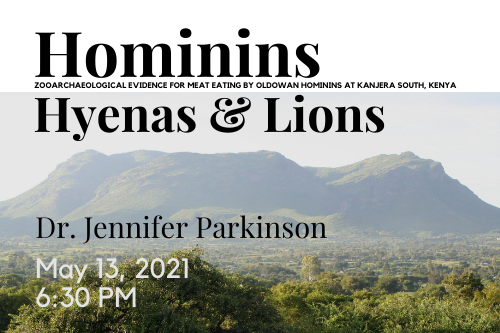 Hominins, Hyenas, and Lions: Zooarchaeological Evidence for Meat Eating Oldowan Hominins at Kanjera South, Kenya
Hominins, Hyenas, and Lions: Zooarchaeological Evidence for Meat Eating Oldowan Hominins at Kanjera South, Kenya
The shift to increased meat consumption is one of the major adaptive changes in hominin dietary evolution and likely had important repercussions for the behavior of our early hominin ancestors. Meat-eating by hominins is well documented at Early Pleistocene (Oldowan) archaeological sites in East Africa by butchery marks on bones. While it is established that Oldowan hominins butchered mammal carcasses, there has been disagreement about whether these carcasses were hunted or scavenged, as well as disagreement about the nature of competition between hominins and large carnivores. The 2-million-year-old zooarchaeological assemblage from Kanjera South (Kenya) offers some of the earliest evidence of routine butchery of mammal carcasses by early members of the genus Homo. Bone surface modifications indicate that hominins were likely not passively scavenging from carnivore kills, but instead gaining early access to prey either through hunting or confrontational scavenging. Modern studies of lion feeding ecology are also shedding additional light on the potential for hominin-carnivore competitive interactions in the past.
Dr. Jennifer Parkinson is a zooarchaeologist and paleoanthropologist interested in the archaeological record related to human diet and evolution. Her research is focused on the behavioral ecology of Plio-Pleistocene hominins in East Africa. Specifically, her work has examined the importance of meat in the diet of early genus Homo. Dr. Parkinson has conducted fieldwork in East Africa for over 20 years, where she is a member of the Homa Peninsula Paleoanthropological Project in Kenya. Currently, she leads the Albertine Rift Paleoanthropology Project exploring fossil sites documenting evidence for hominin evolution and environments outside the better known east African Rift. Dr. Parkinson is an Associate Professor of Anthropology at the University San Diego. She has held a postdoctoral fellowship in the Department of Cell Biology and Anatomy at the University of South Carolina, and is also currently a Research Associate at the Smithsonian’s National Museum of Natural History and a National Geographic Explorer.
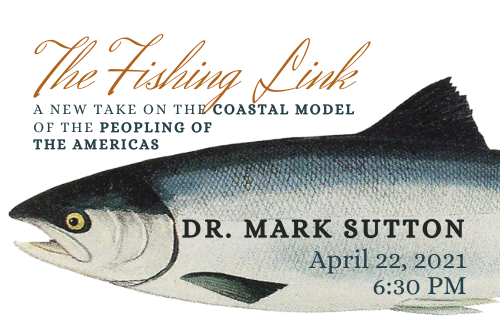 The Fishing Link: A New Take on the Coastal Model of the Peopling of the Americas
The Fishing Link: A New Take on the Coastal Model of the Peopling of the Americas
Dr. Mark Sutton discusses the role of salmonids as a magnet that drew Paleoindians south along the coast and into the Americas south of the ice. Other colonization possibilities and the role of a maritime adaptation with boats are also covered.
Dr. Mark Q. Sutton began his career in 1968, working at a site with the local community college while still in high school. He went on to earn a BA (1972), an MA (1977), and a Ph.D. (1987) in anthropology. He has worked for the US Air Force, the US Bureau of Land Management, various private consulting firms, and taught at a number of community colleges and universities, including California State University, Bakersfield from 1987 to 2007 where he retired as Emeritus Professor of Anthropology. He now teaches at the University of San Diego. From 1986 to 2000, Dr. Sutton served as the Editor of the Journal of California and Great Basin Anthropology. Dr. Sutton has investigated hunter-gatherer adaptations to arid environments, entomophagy, prehistoric diet and technology, and the prehistory of California. Dr. Sutton has worked at more than 150 sites in western North America, has presented some 126 papers at professional meetings, and has published more than 240 books, monographs, articles, and reviews on archaeology and anthropology, including the textbooks Introduction to Native North America, A Prehistory of North America, Archaeology: Science of the Human Past, Introduction to Cultural Ecology, Paleonutrition, Bioarchaeology, and Laboratory Methods in Archaeology.
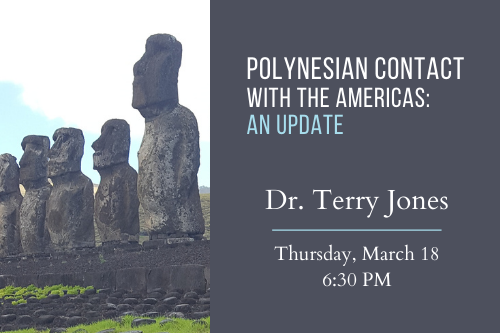 Polynesian Contact with the Americas: An Update
Polynesian Contact with the Americas: An Update
The possibility of prehistoric Polynesian contact with the Americas has been considered by historians, archaeologists, and other scholars for centuries. Most evidence and most scholarly discourse have focused on South America, but as early as the 1930s, Alfred Kroeber suggested that cultural similarities between southern California and Oceania could be the product of prehistoric trans-oceanic diffusion. In this talk, Dr. Terry Jones will review archaeological, linguistic, and other evidence for such contact in North and South America with an emphasis on recent genetic studies that challenge some longstanding ideas.
Dr. Terry Jones joined the Cal Poly San Luis Obispo faculty in 1998. His research interests include North American prehistory, hunter-gatherer ecology, and maritime adaptations. His area of geographic expertise is the central California coast, where he has conducted field research for the last 35 years. He is actively involved in research on a number of issues related to the archaeology and ecology of prehistoric California including: the impacts of late Holocene droughts on indigenous populations, the effects of human-caused extinction of the flightless duck (Chendytes lawi) on nearshore ecology during the Holocene, the prehistory of fishing on the central California coast, and possible pre-Columbian Polynesian contact with the New World. His most recently published books focus on the archaeology and prehistory of the Pecho Coast and Morro Bay in San Luis Obispo County.
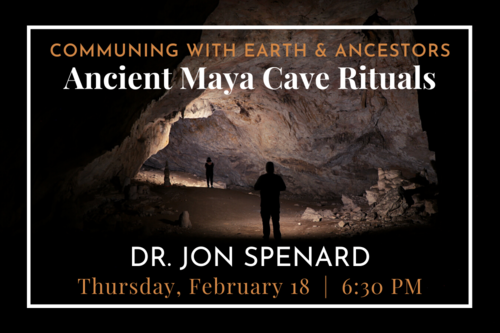 Communing with Earth and Ancestors: Ancient Maya Cave Rituals
Communing with Earth and Ancestors: Ancient Maya Cave Rituals
The ancient Maya are perhaps best known for their jungle-covered cities with large plazas and grand temples standing taller than the forests encasing them. These built places are often depicted as the settings of elaborate state rituals where elites would perform their ceremonial duties in front of the masses. Yet important rituals were not performed only in cities. Archaeological research over the last few decades has come to reveal that caves and cave-like spaces were among the most potent and important places for ritual performances by the ancient Maya. They were the places where the ancestors originally emerged from and where they returned to after their passing. They were also portals to where powerful Earth forces, particularly the rain deity, could be ritually accessed and negotiated with. In this talk, Dr. Jon Spenard will discuss his ongoing cave ritual research in Belize with a particular focus on understanding the relationship between cave rituals and the ancient Maya collapse.
Dr. Jon Spenard is an Assistant Professor of Anthropology at Cal State San Marcos. His current project, the Rio Frio Regional Archaeological Project (RiFRAP), is an investigation of settlement and ritual caves sites in a largely unstudied area of central Belize. With over twenty years of experience in the Maya world, Dr. Spenard has also conducted research elsewhere in Belize, Guatemala, and Mexico for his graduate degrees.
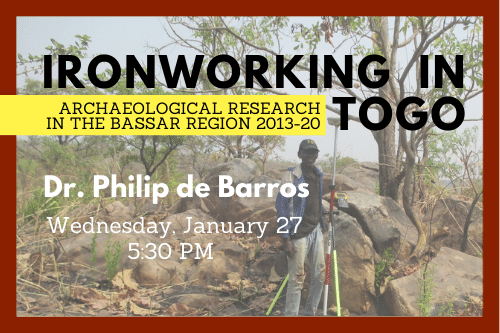 Ironworking in Togo: Archaeological Research in the Bassar Region 2013-20
Ironworking in Togo: Archaeological Research in the Bassar Region 2013-20
A brief review of Bassar research from 1981-2013 will be discussed, focusing on regional survey, developing ceramic chronology, and major discoveries; Early Iron Age discoveries (400 BC-150 AD), including 68-acre smithing center including burials with iron grave goods and smelting site with 4th c. BC furnace remains. This presentation will focus on the ethnoarchaeology of the spatial organization of three abandoned smithing sites and the excavation of five smelting and smithing village sites ranging from the 13th -20th centuries. Discoveries include ceramic tobacco pipe fragments, spindle whorls, smelting slag and furnace remains, faunal remains, charcoal studies, radiocarbon dates, a burial and abundant ceramics.
Dr. Philip de Barros (Stanford, UCLA), Professor Emeritus of Anthropology and former Coordinator of the Archaeology Program at Palomar College (1996-2016). Dr. de Barros has been conducting archaeological research about the Bassar iron industry for the last 40 years. He obtained a B.A. (History) and M.A. (Education) from Stanford University, and later a PhD in Anthropology/Archaeology at UCLA. He began his voyage of discovery in Africa as Peace Corps volunteer and administrator in Togo from 1966-1974, which included teaching African history and geography in French, coaching and basketball, and serving as an officer of the Togolese History and Geography Association and of the Togolese Basketball Federation, as well as serving as coordinator of Peace Corps teachers and in-country training. He later taught History and French at Harbor Day School in Corona del Mar for a few years. After his time at UCLA, he served as Director of Cultural Resources at Chambers Group, Inc., in Orange County for 9 years before starting his teaching career at Palomar College in 1994. He has published numerous peer reviewed articles and book chapters and is currently working on a 2-volume set in French on Bassar ironworking covering the Early and Later Iron Ages. The first volume will be published in January 2021.
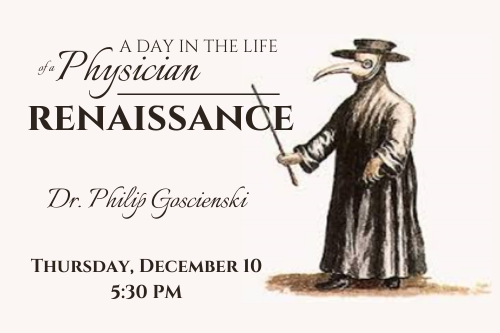 A Day in the Life of a Physician: Renaissance
A Day in the Life of a Physician: Renaissance
The historical period of the Renaissance that has been described as the making of modern man was also the making of modern medicine. Join Dr. Philip Goscienski as he gives an overview of the Renaissance with particular emphasis on medical practices of the day and how they influenced today’s physicians.
Philip J. Goscienski, M.D. is a pediatric infectious diseases specialist with a 47-year career in clinical and academic medicine. Dr. Goscienski reached the rank of Captain in the United States Navy Medical Corps and closed his military career as Head of the Infectious Diseases Branch, Department of Pediatrics, Naval Regional Medical Center, San Diego, California. He was Clinical Professor of Pediatrics at the University of California at San Diego School of Medicine until his retirement. He is the author of more than 700 newspaper and magazine articles as well as several medical journal articles and textbook chapters on various topics in pediatric infectious diseases. Dr. Goscienski has drawn on his interests in biology, anthropology, paleopathology and physical fitness to develop Better Life Seminars, a series of presentations in which he explains how our most distant ancestors lived and how we can apply this knowledge to our lives today.
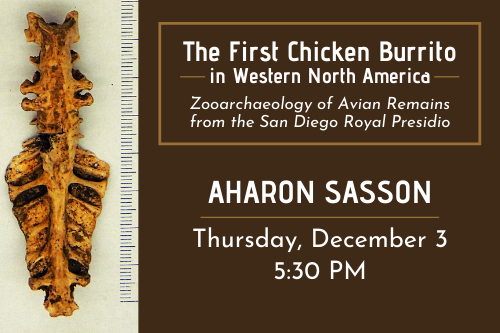 The First Chicken Burrito in Western North America: Zooarchaeology of Avian Remains for the San Diego Royal Presidio
The First Chicken Burrito in Western North America: Zooarchaeology of Avian Remains for the San Diego Royal Presidio
The San Diego Presidio, established in AD 1769, was the first European settlement in Upper California. Very little is known about chicken husbandry in colonial America, which makes this study the first comprehensive analysis of chicken remains in North America. Chickens are scarcely mentioned in historical accounts describing early California, and information on their sex, age, or management is rare. Small-scale poultry production, likely managed by women and children, provided California presidios with a form of subsistence independence.
Dr. Aharon Sasson is the co-director of the San Diego Zooarchaeology Laboratory at the San Diego Natural History Museum. He received his Ph.D. in Archaeology/Zooarchaeology from Tel Aviv University. Aharon has studied faunal assemblages from the ancient Near East as well as from numerous prehistoric and historic sites from California. Aharon is the author of Animal Husbandry in Ancient Israel, a Zooarchaeological Perspective on Livestock Exploitation, Herd Management, and Economic Strategies. Sasson and Susan Arter recently published their study on the chicken remains from the San Diego Presidio in the high regarded journal, American Antiquity.
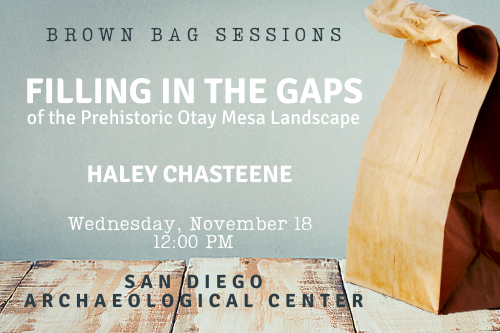 Filling in the Gaps of the Prehistoric Otay Mesa Landscape
Filling in the Gaps of the Prehistoric Otay Mesa Landscape
The prehistoric Otay Mesa landscape in San Diego County, California has been mostly understood through grey literature produced for archaeological studies conducted by cultural resource management firms (CRM). CRM arbitrary rules have created gaps in the overall understanding of this landscape by creating interpretations that focus on questions regarding quantitative topics rather than cultural significance or meaning. To combat this disconnect, landscape and lithic procurement theoretical approaches will be applied to physical archaeological evidence like x-ray fluorescence (XRF) analysis, Santiago Peak Metavolcanic lithic technological analysis, and paleoenvironmental reconstruction in order to produce a holistic interpretation of the prehistoric Otay Mesa landscape. A holistic approach will fill the gaps in research and show that during the early and middle Holocene, the Otay Mesa landscape was an extremely important resource procurement and production hub, which would have been of great significance to the prehistoric peoples of San Diego.
Haley Chasteene has been working as a professional archaeologist for the past 9 years, mostly in San Diego County. She currently works as an Environmental Planner and Archaeologist for Caltrans, District 11. She began her archaeological experiences just out of high school when she started volunteering for the San Diego Archaeological Center. Ms. Chasteene received an A.A in Anthropology and Archaeology from San Diego Mesa College and a B.A in Anthropology from San Diego State University. She has just recently completed an MSc in Archaeology from the University of Glasgow in the UK. Ms. Chasteene’s archaeological interests and experiences mostly stem from San Diego prehistoric archaeology but has field school experience in Belize focusing on the Maya collapse. Also, she was an archaeological supervisor for an Early Bronze site called Kaymakçi in Western Turkey. She has technical expertise with ArcGIS, 3D imaging with structure for motion, RTI capture, and resistivity meters for archaeological survey.
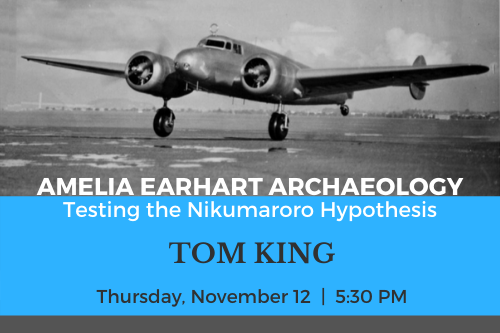 Amelia Earhart Archaeology: Testing the Nikumaroro Hypothesis
Amelia Earhart Archaeology: Testing the Nikumaroro Hypothesis
Aviation pioneers Amelia Earhart and Fred Noonan vanished over the Pacific in 1937. Since 1988 The International Group for Historic Aircraft Recovery (TIGHAR) has been doing archaeology on Nikumaroro, a remote, uninhabited island where evidence suggests Earhart and Noonan may have landed and died. Tom King, who served as TIGHAR’s senior archaeologist until 2018, describes their work and the evidence uncovered to date.
Dr. Tom King holds a PhD from U.C. Riverside, and was an organizer of the Society for California Archaeology. He is best known for his work and writings in Cultural Resource Management, but in 1989, on a whim, he became involved in TIGHAR’s search for Amelia Earhart. He has taken part in eight archaeological visits to Nikumaroro, the latest sponsored by National Geographic in 2019. He has co-authored a non-fiction account of TIGHAR’s work, plus two novels that imagine Earhart’s fate and the discovery of her remains.
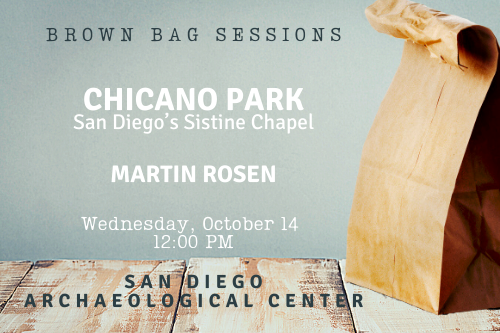 Chicano Park: San Diego’s Sistine Chapel
Chicano Park: San Diego’s Sistine Chapel
Call it blasphemous if you will, Sistine Chapel indeed! Say what you will, you cannot escape the beauty, magnificence, and grandeur of the murals painted on freeway bridge columns in Chicano Park. You are surrounded by the largest collection of outdoor murals in a single public setting in California. Beyond beauty, the park and murals are historically significant for the role they played in the California Chicano Civil Rights Movement. Come hear why and learn why you will want to visit this park where art and the messages communicated in them are as relevant today as they were back in the late 1960s.
Martin D. Rosen is a retired cultural resource professional, with almost 50 years in the profession. Thirty years were spent at Caltrans in San Diego, where he worked on, ran, and oversaw many significant cultural resource investigations in San Diego and Imperial Counties. He continues to research, edit the work of others, and publish in archaeology and paleoanthropology. Born in L.A., and with B.A. and M.A. degrees in hand, he moved to San Diego in 1980 to pursue his Caltrans career. He currently serves on the Board of Trustees of the San Diego Archaeological Center.
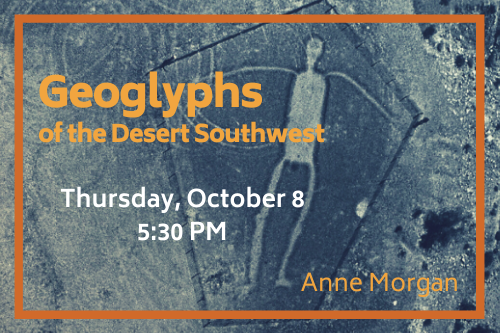 Geoglyphs of the Desert Southwest
Geoglyphs of the Desert Southwest
The deserts of the American southwest contain one of the largest concentrations of geoglyphs outside of Peru’s Nazca Lines. These ancient Native American works of earthen art can be up to hundreds of feet long, and yet are often invisible until viewed from above. Before drones, GPS, or Google Maps, photographer Harry Casey began a unique archaeology project. Armed with nothing more than topographic maps, 35mm film cameras, and his beloved Piper J3 Cub aircraft, Casey spent thirty-five years documenting the region’s geoglyphs before natural erosion and human intervention could destroy these fragile sites. A newly published book, Geoglyphs of the Desert Southwest: Earthen Art as Viewed from Above, authored by Harry Casey and Anne Morgan, collects Casey’s photographs into the first visual record of these beautiful and mysterious features.
Geoglyphs of the Desert Southwest, published by Sunbelt Publications, is the first book dedicated to the earthen art of the southwest deserts of the United States. Steven M. Freers, rock art researcher and co-author of Rock Art of the Grand Canyon Region praises the book, “This definitive book is an elegant historical account of the relentless pursuit to document and comprehend one of humankind’s great enigmas as expressed on desert surfaces. It is a gem, an essential addition to anyone’s library where the mysteries of rock art holds special status.”
About the Authors: The eldest of three sons born into a farming family east of Brawley, California, Harry Casey had always been interested in flying, photography, and desert archaeology. These interests led him to take classes from noted archaeologist and historian Jay von Werlhof at the Imperial Valley College in El Centro, California. After many years of flying and photographing, Casey donated his extensive collection of photographs and research to the Imperial Valley Desert Museum, where Anne Morgan was the Head Archivist/Curator. Anne met Harry and his wife, Meg Casey, and what began as an archival project on nearly 10,000 aerial images became a friendship and partnership as she helped edit Harry’s original manuscript into a published book.
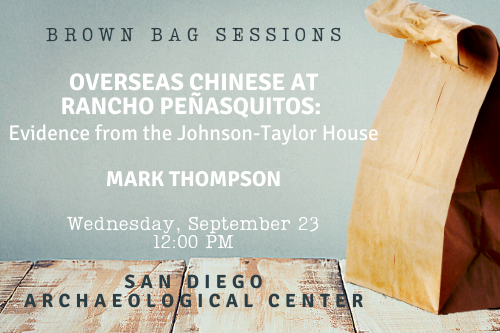 Overseas Chinese at Rancho Peñasquitos: Evidence from the Johnson-Taylor House
Overseas Chinese at Rancho Peñasquitos: Evidence from the Johnson-Taylor House
This presentation summarizes the results of historical archaeology conducted at Rancho Peñasquitos, San Diego Calif.. This investigation focuses on a previously under-reported population of Chinese employees working at the Ranch in 1880. In addition to reviewing evidence supporting the presence of Chinese workers at Penasquitos this report attempts to develop an understanding of this groups experience at the site by placing them in a broader historical context.
Mark Thompson completed his AA degree in Anthropology/Archaeology from Palomar College in 2019. His archaeological training includes field work in the San Diego area as well as in Central America and Italy. He has twice participated in excavations at Los Peñasquitos Ranch under direction of faculty from Palomar. Mark holds a Bachelor degree in Biology and a Master’s degree in Public Health and worked in San Diego’s Biotech industry before shifting his focus to archaeology in 2015.
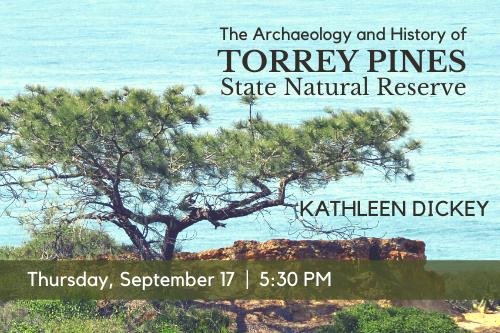 The Archaeology and History of Torrey Pines State Natural Reserve
The Archaeology and History of Torrey Pines State Natural Reserve
People have lived on or near Torrey Pines State Natural Reserve for at least 10,000 years. What does the archaeological record tell us about how they survived? When the Spanish first came to San Diego, the people there were known as the Kumeyaay. What natural resources did they utilize? Did they have a village there? What happened over historical times to those people?
Kathleen Dickey is a former microbiologist who specialized in infectious disease diagnostics. After her retirement, she followed her other interests: San Diego archaeology, natural history, and cultural history. During an internship with Palomar College, she began a volunteer research relationship with San Diego Archaeological Center starting in 2005. She has been a docent naturalist at Torrey Pines SNR since 2008.
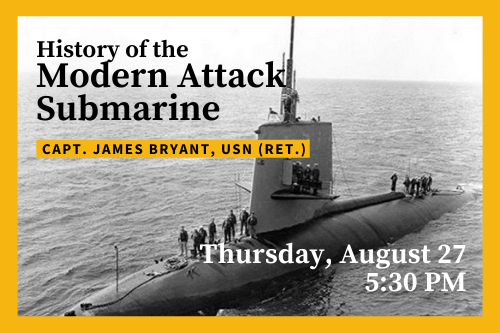 History of the Modern Attack Submarine
History of the Modern Attack Submarine
In 1941 submarines became sophisticated weapons of war, but were still a torpedo boat that could only submerge for short periods of time to avoid attack. Over the next 20 years, with a changing shape and development of sensors, submarines became quieter, faster, and operated at increased depths. These significant improvements resulted in the THRESHER Class submarine, the template for all modern nuclear submarines. This virtual event will be held via Zoom and is limited to 100 attendees.
Captain Jim Bryant, U.S. Navy (Retired) received a Bachelor of Science degree from the U.S. Naval Academy and was commissioned an Ensign in 1971. Bryant was selected by Admiral Rickover for the naval nuclear propulsion training and subsequently served on five nuclear submarines that culminated with commanding USS GUARDFISH (SSN 612) from 1987-1990. Three of these submarines were homeported in San Diego, CA. During his 23-year career he participated in Cold War Missions in the Gulf of Aden; North, Norwegian, Bering and Arabian Seas, and the Seas of Japan and Okhotsk and assisted the Royal Navy during the Falklands War as a Staff Officer in London, UK. After a tour in the Pentagon he retired from the Navy in 1994 and started a small business. Bryant also researched the sinking of the nuclear submarines THRESHER and SCORPION. In 2015 he returned to San Diego, took courses in Archeology and became a volunteer at the San Diego Archeological Center. His research on the loss of USS THRESHER (SN 593) found that the Navy’s version of the disaster is inaccurate and resulted in publications of several articles. In July 2019 he sued the Navy for information on THRESHER after his Freedom of Information Act request was ignored.
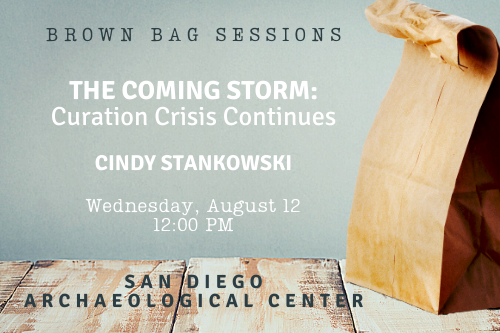 The Coming Storm: Curation Crisis Continues
The Coming Storm: Curation Crisis Continues
Do you hear that? A massive rumbling in the distance, getting closer and closer? It’s the millions of artifacts, pouring out of Cultural Resource Management (CRM) companies. CRM firms are going out of business, merging, moving or simply can no longer afford the dead storage. This is chapter two of the Curation Crisis. The time is now to address this issue. Please joins us as Cindy Stankowski, Executive Director, leads this discussion.
Cindy Stankowski’s personal commitment is to continue to have a positive impact in the community by making new ideas and information accessible in the museum setting. Ms. Stankowski received a Bachelor’s degree summa cum laude in Anthropology from San Diego State University and a Master’s degree in Museum Studies from San Francisco State University. She has been with the San Diego Archaeological Center since 1996, leading the effort to preserve our archaeological legacy. She brings an understanding of curation issues and museum management to SDAC and has led symposia on curation throughout the state. Ms. Stankowski also seeks new and innovative ways for the public to connect with the past, including exhibits, seminars and school presentations.
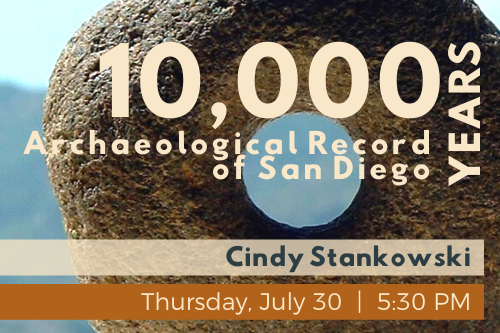 10,000 Years: Archaeological Record of San Diego
10,000 Years: Archaeological Record of San Diego
San Diego is blessed with abundant natural and cultural resources. Over 36,000 archaeological sites have been discovered in San Diego County. These sites contain the material culture of people who have lived in the region for over 10,000 years. This presentation will reveal what archaeology has uncovered about the ancient peoples who called San Diego home. Archaeology is a wonderful tool for understanding the past and bringing context to the present. Join us for a Living Room Lecture on 10,000 years of San Diego history and a new understanding of the past. This virtual event will be held via Zoom and is limited to 100 attendees.
Cindy Stankowski’s personal commitment is to continue to have a positive impact in the community by making new ideas and information accessible in the museum setting. Ms. Stankowski received a Bachelor’s degree summa cum laude in Anthropology from San Diego State University and a Master’s degree in Museum Studies from San Francisco State University. She has been with the San Diego Archaeological Center since 1996, leading the effort to preserve our archaeological legacy. She brings an understanding of curation issues and museum management to SDAC and has led symposia on curation throughout the state. Ms. Stankowski also seeks new and innovative ways for the public to connect with the past, including exhibits, seminars and school presentations.
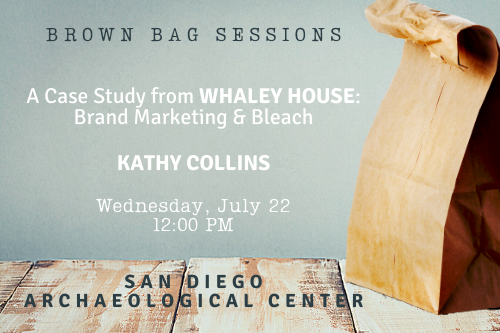 A Case Study from Whaley House: Brand Marketing and Bleach
A Case Study from Whaley House: Brand Marketing and Bleach
Often while analyzing archaeological data, a seemingly ordinary artifact or assemblage tells an unexpected story. In my case, this was the dozen amber embossed bleach bottles from the Whaley House collection. While analyzing the collection, I developed several basic research questions: when was bleach introduced, who used it, and most importantly, why? This “why” led to an exploration of marketing, branding, and consumption. Why was a product like Clorox (unknown at the turn of the 20th century) widely consumed and considered essential circa WWII? Did an increase in exposure to brand name advertising correlate with increased bleach consumption? By taking a look at various trends around the WWII era, I became aware of the profound impact of advertising and marketing on bleach consumption. This is an important factor to consider as we contemplate what the archaeological record of the future will look like. In this presentation I will briefly discuss my findings, a short history of bleach, how brand marketing and advertising affect the consumer, and what it means to the archaeological record.
Kathy Collins is an archaeologist for California State Parks, Southern Service Center and volunteer at San Diego Archaeological Center. She received her Master’s Degree in Anthropology with a focus on archaeology. Kathy is especially interested in historical artifacts. Her thesis entitled An Anthropological and Archaeological Analysis of American Victorian (1876-1915) and Progressive Era (1900-1920) Medicine in San Diego, California focused on the glass collection from the Whaley House excavation. As an archaeologist for State Parks, Kathy travels throughout Southern California monitoring construction projects, surveying and excavating as well as curating and cataloguing artifact collections in the lab and writing reports. Throughout her travels and work in Southern California, Kathy looks for the hidden stories that lie beneath the surface.
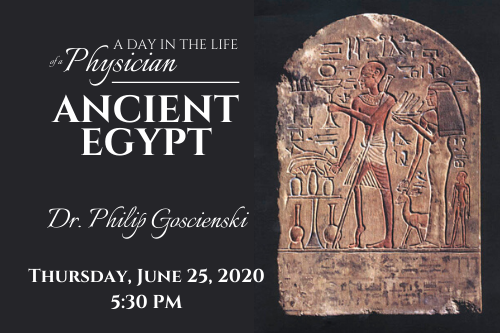 A Day in the Life of a Physician: Ancient Egypt
A Day in the Life of a Physician: Ancient Egypt
Ancient Egypt had some unusual characteristics beyond pyramids and mummies. Diseases of the era are depicted in temple artwork and Egyptian physicians were respected for their knowledge in the ancient world. Join us for our first Living Room Lecture as Dr. Philip Goscienski presents a day in the life of a physician in Ancient Egypt. This event is limited to 100 attendees.
Philip J. Goscienski, M.D. is a pediatric infectious diseases specialist with a 47-year career in clinical and academic medicine. Dr. Goscienski reached the rank of Captain in the United States Navy Medical Corps and closed his military career as Head of the Infectious Diseases Branch, Department of Pediatrics, Naval Regional Medical Center, San Diego, California. He was Clinical Professor of Pediatrics at the University of California at San Diego School of Medicine until his retirement. He is the author of more than 700 newspaper and magazine articles as well as several medical journal articles and textbook chapters on various topics in pediatric infectious diseases. Dr. Goscienski has drawn on his interests in biology, anthropology, paleopathology and physical fitness to develop Better Life Seminars, a series of presentations in which he explains how our most distant ancestors lived and how we can apply this knowledge to our lives today.
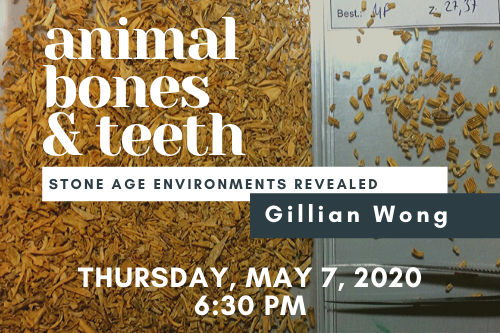 Animal Bones and Teeth: Stone Age Environments Revealed
Animal Bones and Teeth: Stone Age Environments Revealed
Zooarchaeologists seek to answer questions about the human past using animal remains from the archaeological record. These researchers explore what people ate, what environments were like, the movements of animals across landscapes, relationships between people and animals, and more. In this talk Gillian Wong will dive into what it means to be a zooarchaeologist and how animal remains can be used to address several key questions in our understanding of the human past. She will draw specifically from her PhD work that uses the remains of micro-mammals, like rodents and insectivores, from Langmahdhalde, an archaeological site in southwestern Germany, to reconstruct climates and environments during the stone age. What kind of vegetation existed during this time and how cold was it? But more importantly, what implications does all this have for human settlement of the region? This lecture is limited to 100 attendees.
Gillian Wong is a PhD student in archaeology at the University of Tuebingen in Germany. Her specialty is zooarchaeology, or animal (faunal) remains in the archaeological record. She is primarily interested in using animal remains to explore how large-scale changes in climate affected prehistoric hunter-gatherers at the local level. Currently, she is the zooarchaeologist for a project in southwestern Germany that is excavating one of the first Magdalenian (~15,000 years before present) sites to be discovered in the region since the 1970s. She has a Bachelor’s degree in Anthropology from the University of California, Davis and a Master’s degree in Anthropology from the University of Utah. When she’s not doing archaeology, Gillian enjoys hiking with her dog and husband, swimming, and reading.